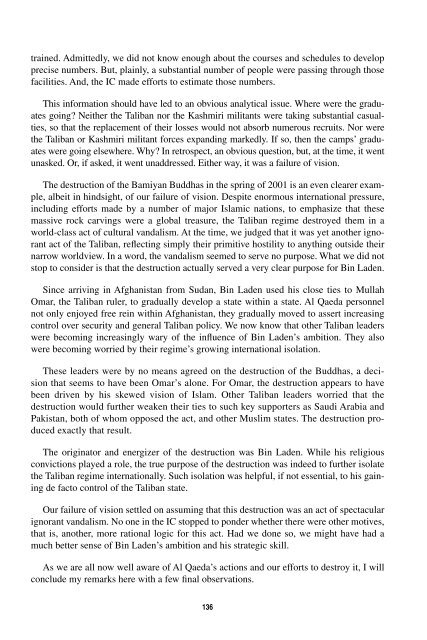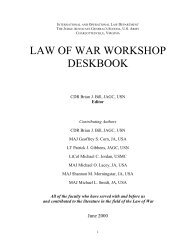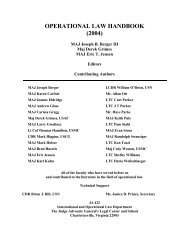learning with professionals - Higgins Counterterrorism Research ...
learning with professionals - Higgins Counterterrorism Research ...
learning with professionals - Higgins Counterterrorism Research ...
Create successful ePaper yourself
Turn your PDF publications into a flip-book with our unique Google optimized e-Paper software.
trained. Admittedly, we did not know enough about the courses and schedules to develop<br />
precise numbers. But, plainly, a substantial number of people were passing through those<br />
facilities. And, the IC made efforts to estimate those numbers.<br />
This information should have led to an obvious analytical issue. Where were the graduates<br />
going? Neither the Taliban nor the Kashmiri militants were taking substantial casualties,<br />
so that the replacement of their losses would not absorb numerous recruits. Nor were<br />
the Taliban or Kashmiri militant forces expanding markedly. If so, then the camps’ graduates<br />
were going elsewhere. Why? In retrospect, an obvious question, but, at the time, it went<br />
unasked. Or, if asked, it went unaddressed. Either way, it was a failure of vision.<br />
The destruction of the Bamiyan Buddhas in the spring of 2001 is an even clearer example,<br />
albeit in hindsight, of our failure of vision. Despite enormous international pressure,<br />
including efforts made by a number of major Islamic nations, to emphasize that these<br />
massive rock carvings were a global treasure, the Taliban regime destroyed them in a<br />
world-class act of cultural vandalism. At the time, we judged that it was yet another ignorant<br />
act of the Taliban, reflecting simply their primitive hostility to anything outside their<br />
narrow worldview. In a word, the vandalism seemed to serve no purpose. What we did not<br />
stop to consider is that the destruction actually served a very clear purpose for Bin Laden.<br />
Since arriving in Afghanistan from Sudan, Bin Laden used his close ties to Mullah<br />
Omar, the Taliban ruler, to gradually develop a state <strong>with</strong>in a state. Al Qaeda personnel<br />
not only enjoyed free rein <strong>with</strong>in Afghanistan, they gradually moved to assert increasing<br />
control over security and general Taliban policy. We now know that other Taliban leaders<br />
were becoming increasingly wary of the influence of Bin Laden’s ambition. They also<br />
were becoming worried by their regime’s growing international isolation.<br />
These leaders were by no means agreed on the destruction of the Buddhas, a decision<br />
that seems to have been Omar’s alone. For Omar, the destruction appears to have<br />
been driven by his skewed vision of Islam. Other Taliban leaders worried that the<br />
destruction would further weaken their ties to such key supporters as Saudi Arabia and<br />
Pakistan, both of whom opposed the act, and other Muslim states. The destruction produced<br />
exactly that result.<br />
The originator and energizer of the destruction was Bin Laden. While his religious<br />
convictions played a role, the true purpose of the destruction was indeed to further isolate<br />
the Taliban regime internationally. Such isolation was helpful, if not essential, to his gaining<br />
de facto control of the Taliban state.<br />
Our failure of vision settled on assuming that this destruction was an act of spectacular<br />
ignorant vandalism. No one in the IC stopped to ponder whether there were other motives,<br />
that is, another, more rational logic for this act. Had we done so, we might have had a<br />
much better sense of Bin Laden’s ambition and his strategic skill.<br />
As we are all now well aware of Al Qaeda’s actions and our efforts to destroy it, I will<br />
conclude my remarks here <strong>with</strong> a few final observations.<br />
136

















